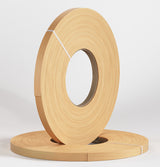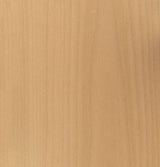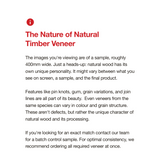Material: Natural Timber Veneer
Available Options: Pre-Glued and Non-Glued
Recommended Application: For application on panel edges including MDF, plywood, particleboard, and laminate.
Finish: Timber veneer edge banding is supplied unfinished. It must be stained, polished, or sealed post-installation to achieve the desired aesthetic and to enhance durability.
Installation (Pre-Glued): Pre-Glued timber veneer edge banding features a heat-activated adhesive. To install, gently warm the veneer using a heat gun—applying even, controlled heat along the entire length—to activate the adhesive without causing damage. Once activated, firmly press the veneer onto the substrate to achieve a secure bond.
Installation (Non-Glued/Standard): Standard timber veneer edge banding does not include a pre-applied adhesive. To install, manually apply a high-performance wood adhesive—such as contact adhesive—to the panel edge. Ensure the adhesive is compatible with both the timber veneer and the substrate. After applying the adhesive evenly, carefully press the veneer into place and maintain consistent pressure to establish a durable, long-lasting bond.
Care & Maintenance: Clean with a soft, lightly damp cloth and a mild detergent. Avoid abrasive cleaners, harsh chemicals, or solvents. Protect from prolonged water exposure, direct heat, and strong UV light to prevent discolouration and deterioration. Although the veneer is durable, excessive force or impact may cause damage.
Wet Area Suitability: Timber veneer edging is not recommended for wet areas. Due to the natural characteristics of wood, prolonged exposure to moisture can lead to absorption, swelling, or damage, even when finished. It is best suited for interior applications in low-humidity environments where direct water contact is unlikely.
Important notice: Due to the natural characteristics of timber and the batch manufacturing process, variations in colour and pattern may occur within veneers of the same species. Although we make every effort to closely match the veneer panels and edge banding when preparing your order, these differences are inherent to natural wood and should not be considered a product defect.
To give you the best rate, we offer various delivery options based on your destination, product type and order size. View our rates below or proceed to checkout to calculate your delivery cost.
Free Pickup - Somerton VIC
Free pickup available between 7.00am - 3.00pm Monday to Friday, excluding public holidays.
Trade Local Delivery - Forklift Required
Flat-rate delivery for local trade customers. All trade deliveries require a forklift for safe unloading. Estimated 1 business day (excluding factory lead time).
| Within 50 km of Somerton VIC | $50 flat rate |
| 50-100 km from Somerton VIC | $75 flat rate |
Panel Products
Panel product delivery rates scale with weight and distance to give you the best possible price across Australia. Estimated 2-3 business days (excluding factory lead time).
Please review our Panel Product Delivery Safety Guidelines before ordering.
| Total Order Weight (kg) | VIC | NSW | ACT | SA | QLD | NT | WA | TAS |
|---|---|---|---|---|---|---|---|---|
| Up to 49 kg | $70 | $95 | $95 | $100 | $110 | $135 | $135 | $135 |
| 50 - 149 kg | $120 | $165 | $165 | $180 | $190 | $230 | $230 | $230 |
| 150 - 249 kg | $140 | $250 | $250 | $280 | $300 | $370 | $370 | $370 |
| 250+ kg | $150 | $470 | $470 | $495 | $510 | $600 | $600 | $600 |
Lightweight Items
Flat-rate shipping Australia-wide. Estimated 2-8 business days (excluding factory lead time).
| Edge Banding, Timber Oils and Pre-Glued Veneer Leaves | $40 flat rate Australia-wide |
| Paper Back Veneers, 1mm Laminates and Liners (excl. Magnetic Laminate) | $70 flat rate Australia-wide |
Samples
Affordable sample shipping with free standard post in Victoria.
| Local Delivery VIC | FREE Standard Post (2-8 business days) |
| $15 Express Post (1-4 business days) | |
| Rest of Australia | $15 Standard Post (2-8 business days) |
What is veneer edging?
In the cabinetry and furniture industries edging refers to a narrow strip of veneer placed around the edges of a panel or sheet. Manufacturers use edging (or ‘edge band’) to cover the exposed edges of raw panel substrates such as MDF or particleboard. The benefit of edging is two-fold. First, it’s visually more appealing. Once applied it creates the appearance of a solid material or an illusion of solid timber. And second, as it seals the exposed edge and improves the sheets resistance to moisture and damage.
What is pre-glued edging?
Bord's standard veneer edging has no adhesive backing however, some popular edging is available pre-glued. Pre-glued edging has a heat-activated glue applied to the back of the veneer edge strip for faster application onto substrates.






